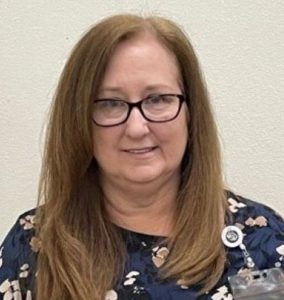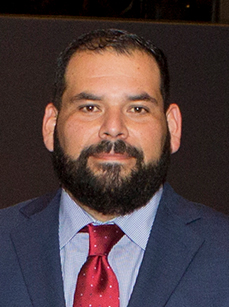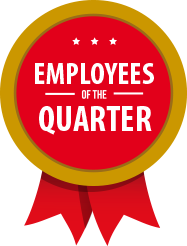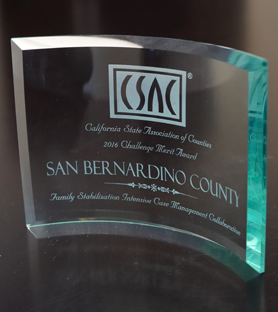NACo
National Association of Counties (NACo) recognizes groundbreaking county government programs throughout the nation through its Achievement Awards. The Achievement Awards is an annual non-competitive awards program with 18 different categories that reflect the vast, comprehensive services counties provide including children and youth, criminal justice, county administration, planning, information technology, health and more.
Customer Service Center Average Handle Time Contest
The San Bernardino County Transitional Assistance Department (TAD) introduced the Average Handle Time (AHT) Contest within the Customer Service Center (CSC) to motivate employees and improve performance. In response to an increase in AHT in 2024, the contest challenged CSC Eligibility Workers (EWs) to reduce their AHT by at least one minute. CSC EWs receive and process telephone calls from beneficiaries and prospective beneficiaries of public assistance programs. This initiative fostered friendly competition, teamwork, and accountability among staff while encouraging efficiency in handling customer inquiries. Incentives were awarded to top-performing units and CSC locations, boosting morale and engagement. By aligning individual efforts with organizational goals, the contest demonstrated how public sector agencies can motivate employees through recognition and clear performance metrics. This innovative approach not only enhanced employee performance but also improved the quality of public service, benefiting both staff and the residents we serve.
Robotic Calls and API for Enhanced Customer Communication
The San Bernardino County Transitional Assistance Department (TAD) in collaboration with the Information Technology Support Division (ITSD), California Statewide Automated Welfare System (CalSAWS), and Voicent, a contracted provider, developed an innovative automated pre-recorded robotic calls (robocalls) system and Application Programming Interface (API) Initiative to enhance customer communication in response to the requirements of Assembly Bill (AB) 79. AB 79 mandated streamlined verification procedures and effectiveness in customer outreach efforts for CalFresh recipients. Robocalls and API ensure San Bernardino County complies with AB 79 by delivering timely reminders and important notifications to customers about upcoming Eligibility Status Report or Recertification/Re-Evaluation packet deadlines, while automatically documenting each contact attempt in the case record. The Robocall and API Initiative automates reminders, reduces staff workload, and improves efficiency by ensuring timely notification.
Pre-Recorded CalFresh Rights and Responsibilities (R&Rs)
The pre-recorded R&Rs improves the interview experience for CalFresh customers and allows eligibility staff to make the interview process more efficient. The pre-recorded R&Rs provides applicants and recipients a uniform, standardized review of the R&Rs which empowers CalFresh customers with the knowledge of their responsibilities to the program and an understanding the rights afforded to all CalFresh applicants and recipients.
Customer Service Center (CSC) Enhanced Call Queue
The CSC IVR significantly improved the customer experience with an innovative and focused approach. This notable addition to San Bernardino Counties’ telephonic infrastructure provides its residents rapid assistance to critically needed programs and information while alleviating additional workload strain on routine business operations.
Live Web Chat Expansion with Work Experience (WEX) Staff
Live web chat with WEX staff enhances the customer experience by substantially reducing overall call wait times while maintaining service levels. It has provided customers the ability to access faster and more efficient responses to general questions from the convenience of their computers or mobile devices, enhancing customer satisfaction and exceeding expectations. The expansion has also had a significant and positive impact in the handling of caseloads, as it reduced the amount of time staff spend on calls.
Medi-Cal Public Health Emergency – Public Service Employees Program (PSE)
Use of PSE staff is proactive in nature and helps to improve TAD’s operational workflow while meeting departmental customer service goals. More importantly, the program ensures members of the San Bernardino community have ongoing health care, as it ensures uninterrupted access to Medi-Cal services while promoting health and wellness which helps to create a thriving community.
TAD College Student Outreach
The College Student Outreach campaign was developed by the San Bernardino County Transitional Assistance Department (TAD) and the Department of Public Health (DPH) Nutrition and Wellness Services, which administers CalFresh Healthy Living, to help bring awareness to college students regarding the availability of CalFresh. To help reach college students, TAD has taken a proactive approach in reaching out to local colleges and institutions to establish communication channels. These efforts have been enhanced by partnering with multiple local colleges to provide information about the CalFresh program, including TAD’s participation in multiple college outreach events and presentations. In addition, TAD has created resources for college staff and students, including a CalFresh college toolkit and pamphlet, to help educate students on program eligibility and access.
TAD Employee Recognition – Employee of the Quarter
The San Bernardino County Transitional Assistance Department (TAD) Management team developed the Employee Recognition program to recognize and reward employees on a quarterly basis for exceptional work performance and exceeding the Department’s expectations while upholding its goals and values. This program is in part an effort to motivate and encourage employees to succeed, while creating a positive and encouraging work environment, in addition to increasing employee satisfaction, enjoyment, and continuously providing excellent service to TAD customers. TAD employs an estimated 2,500 employees who offer various services to an estimated 1 million customers in San Bernardino County, which include the following programs: • CalWORKS – monthly cash assistance to eligible families with dependent children in the home. • CalFresh – nutritional benefits for eligible individuals and households to purchase food items to help improve health and meet their nutritional needs. • Medi-Cal – free or low-cost health coverage for eligible California residents. Each employee has an equal opportunity to be recognized and rewarded for their individual achievements, contributions to the department, and service to the many TAD customers in San Bernardino County. These achievements and contributions enhance organizational values and increase and sustain customer satisfaction. As part of the department’s efforts to highlight the stellar work performed by employees and help aid the department’s succession plan by identifying future leaders within the department, TAD honors selected employees through Employee of the Quarter awards. Additionally, the Employee Recognition program will help aid in the department’s succession planning by identifying future leaders within the Department.
Automated Assistants
Automated Assistants are a creative use of technology to help bridge the gap between increased workload and limited staff available while still providing quality customer service. An innovated way to enhance and simplify the customer experience, increase overall satisfaction and offer increased options for self-service. In a collaborative partnership, San Bernardino County Transitional Assistance Department (TAD) with California Statewide Automated Welfare System (CalSAWS) developed the Automated Assistants which use customer responses to system prompts, allowing the customer to verify their identity, provide them with case specific information and prompt them with potential self-service options based on the reason for the call.
TAD/SWAG Collaboration (with DBH)
The San Bernardino Transitional Assistance Department (TAD) and Department of Behavior Health (DBH), and the Social Work Action Group (SWAG) collaborated to assist individuals who were chronically homeless or at-risk of becoming homeless gain access to benefits and programs. Participation in this collaboration is a key component to ensure low-income individuals at-risk of homelessness or the chronically homeless are connected to the direct services SWAG provides to help achieve sustainable independence through community support. The collaboration between TAD, DBH and SWAG provides an opportunity to build community partnerships while serving residents, in accordance with San Bernardino County’s mission to enhance quality of life among its residents.
Medi-Cal Health Navigators Program
Through a special program allocation from the Department of Health Care Services, San Bernardino County Transitional Assistance Department (TAD) partnered with Loma Linda University (LLU) in 2020 to promote and expand the Medi-Cal program by reaching out to targeted uninsured high-risk populations. The Health Navigators program resulted in the successful completion of approximately 1,500 Medi-Cal applications directly linked to outreach at community events from November 2020 to January 2022, and is continuing to offer services throughout the region.
TAD-DPH CalFresh Targeted Outreach
The San Bernardino County Transitional Assistance Department (TAD) and Department of Public Health (DPH) enhanced collaboration to facilitate a targeted outreach initiative that promoted the CalFresh program (California’s Supplemental Nutrition Assistance Program [SNAP]) to the food insecure population within the county. Participation in this outreach is a key component to ensuring constituents experiencing food instability are aware of the CalFresh program and how they can apply for benefits. Targeted outreach offers TAD and DPH an opportunity to build community partnerships while serving residents, all while aligning with San Bernardino County’s mission to enhance quality of life. During DPH County Nutrition Action Partnership (CNAP) and Food Rescue Anti-Hunger Coalition (FRAHC) meetings that focus on addressing food insecurity and access to healthy foods, TAD staff provide an overview of the CalFresh program (including printed publications), clarify common misconceptions, and provide Community and Faith Based Organizations (CBOs/FBOs), and local school districts with information on how to become an application assistor. Participation in the targeted outreach approach has provided increased access to this vital program and promotes food security for vulnerable county residents.
CalFresh Employment and Training (E&T) COVID-19 Response
The County of San Bernardino Transitional Assistance Department (TAD) provides mandatory CalFresh work registrants with access to the CalFresh Employment and Training program. This program offers customers assistance in obtaining a job, retaining a job for an extended period of time, and achieving self-sufficiency. Participants are assessed by TAD and the county’s Workforce Development Department (WDD) for participation in activities related to supervised job search, educational programs, and retention services. The offering of these services has become increasingly critical due to the onset of Coronavirus Disease-2019 (COVID-19) pandemic and subsequent economic downturn. Due to the pandemic, administration of the program moved to a virtual platform to ensure the safety of customers, county employees, and surrounding communities. Despite the challenges of administering the program virtually and the uncertainties related to the pandemic, San Bernardino County has been able to provide uninterrupted service to customers. The County also expanded the initial pilot phase of Employment and Training (which included only select offices), to a countywide program. In 2020, 41% of Employment and Training registrants successfully completed the program and/or gained employment, with an additional 23% receiving targeted support to obtain a high school diploma or General Education Development (GED).
Housing Services Assistance Agreement – HSP Master Leasing
The Housing Support Program (HSP) Housing Services Assistance Agreement (HSAA) is San Bernardino County’s version of a Master Lease Agreement. HSAA was implemented in April 2019 t to address homelessness for low-income families. The HSP and the HSAA strategy operate via a partnership between the Transitional Assistance Department (TAD) and the Housing Authority of the County of San Bernardino (HACSB). To successfully implement and administer HSP and HSAA, HACSB subcontracted their affiliate local non-profit organization Knowledge and Education for Your Success (KEYS) to serve as the primary HSP provider. HSAA involves KEYS negotiating the leases for a unit, or block of units, for high-risk homeless customers and acting as a safety-net to mitigate property rental risks. HSAA protections and/or incentives for property owners/managers are provided in exchange for the relaxation of tenant screening criteria. HSAA assists with easing owner/manager concerns over rent payments, property damage, neighbor relations, and other issues. HSAA gives California Work Opportunity and Responsibility to Kids (CalWORKs) families, who are struggling with homelessness, the opportunity to demonstrate their stability and reliability to landlords. The primary goal of HSAA is to provide rapid rehousing assistance to CalWORKs eligible homeless families and quickly move families back into permanent housing.
TAD-DAAS-PG CalFresh Targeted Outreach to Seniors and Disabled Persons SSI Cash-out outreach
The San Bernardino County Transitional Assistance Department (TAD) and Department of Aging and Adult Services – Public Guardian (DAAS-PG) began a collaboration in 2019 to facilitate a Targeted Outreach program that promoted the CalFresh program (California’s Supplemental Nutrition Assistance Program [SNAP]) to the elderly and disabled population within the county. Participation in this outreach is a key component with ensuring elderly and disabled residents experiencing food instability are aware of the CalFresh program and how they can apply for benefits. Targeted Outreach offers TAD and DAAS-PG an opportunity to serve the local community while aligning with San Bernardino County’s mission to enhance county residents’ quality of life. During annual home visits, DAAS-PG staff provide a general overview of the program (including an informative brochure), clarify common misconceptions, and assist customers with applying for CalFresh benefits. Participation in the Targeted Outreach approach has provided an additional food resource and promotes food security for vulnerable county residents.
CSAC
The California State Association of Counties (CSAC) Challenge Awards are part of a competitive recognition program that honors the best and most innovative programs developed and implemented by California’s 58 counties. These unique awards recognize the innovative and creative spirit of California county governments as they find innovative, effective and cost-saving ways to provide programs and services to their citizens. San Bernardino County is consistently one of the nation’s most-honored counties in terms of state and national awards for innovative and cost-saving public service. The CSAC Challenge Awards provide meaningful examples of how County employees are committed to achieving the Countywide Vision and creating a county in which those who reside and invest can prosper and achieve well-being.
Housing Support Program Collaborative:
In the Health and Human Services category, San Bernardino County received a prestigious Challenge Award for its Housing Support Program Collaborative, which fills in gaps in services available to homeless families who receive Temporary Assistance for Needy Families (TANF). The Transitional Assistance Department (TAD) along with the Department of Behavioral Health (DBH), Housing Authority and Knowledge and Education for Your Success (KEYS) joined together to help families overcome homelessness. Since the collaborative began in 2015, 644 families have been permanently housed.
AWARD FOR EXCELLENCE
Celebrated nationally the first week of May since 1985, Public Service Recognition Week (PSRW) is organized annually to honor the men and women who serve our nation as federal, state, county and local government employees. A participant of this nationwide celebration for nearly 30 years, San Bernardino County honors selected employees through the Award for Excellence program. One employee from each County department is selected for an Award for Excellence, based on specific criteria including customer service, initiative and leadership, accomplishments and the commitment to the realization of the Countywide Vision. Recipients of the Award for Excellence share an exceptional level of dedication in what they do as County employees and as members of their community toward achieving the Countywide Vision.
- 2013 TAD Award for Excellence Recipient – Elizabeth Lepe
- 2014 TAD Award for Excellence Recipient – Aron Martinez
- 2015 TAD Award for Excellence Recipient – Richard Calles
- 2016 TAD Award for Excellence Recipient – Michele Flores
- 2017 TAD Award for Excellence Recipient – Rodney Barrios
- 2018 TAD Award for Excellence Recipient – Georgina Noriega
- 2019 TAD Award for Excellence Recipient – Stephanie Maldonado
- 2020 TAD Award for Excellence Recipient – Gina Day
- 2022 TAD Award for Excellence Recipient – Maryann Alvarado
- 2024 TAD Award for Excellence Recipient – Angelica Ruiz
- 2025 TAD Award for Excellence Recipient – Charlene Jones
Summaries were read about the recipients during the ceremony (these are only brief summaries of the selection forms submitted): *No Release of Liability forms were obtained for published use of the selection forms or summarized versions.
ARCHIVES
- Charlene Jones|2025Charlene Jones|2025
- Angelica Ruiz|2024Angelica Ruiz|2024
- Maryann Alvarado|2022Maryann Alvarado|2022
- Gina Day|2020Gina Day|2020

CHARLENE JONES | 2025
Charlene has been instrumental to the ongoing success of the TAD Volunteer Income Tax Assistance (VITA) program. Her commitment to service and excellence is reflected not only in her work but in the lasting impact she continues to make across San Bernardino County. Charlene actively mentors and supports new Work Experience employees, playing a pivotal role in developing a skilled and empowered workforce. Her contributions reflect the kind of leadership, integrity, and community-driven spirit that align with TAD’s mission to support thriving, healthy communities.

ANGELICA RUIZ | 2024
Angelica Ruiz is the Transitional Assistance Department’s Primary Point of Contact for the California Statewide Automated Welfare System (CalSAWS), which is used to effectively administer the CalWORKs, CalFresh, and Medi-Cal programs to San Bernardino County residents. These programs support the diverse members of the community with financial, nutritional, and/or medical needs and help these families to attain self-sufficiency. Her exceptional knowledge of the CalSAWS system functionality not only supports department staff but our Human Services support divisions as well. She is an advocate for continuous improved system functionality so that we can ensure accuracy and innovation in program benefit issuance for our customers. Angelica is committed to serving the community and working to enhance customer service experience for all members of the public who encounter or may need support from our department.

MARYANN ALVARADO | 2022
Maryann Alvarado embodies excellence in the workplace. Her extensive knowledge, “can do” attitude, compassion, and professionalism as a District Manager for the Transitional Assistance Department encourages the success of all who work with her. She is a leader in in the Department and in the community. She maintains a global vision and consistently takes the lead on distribution of work assignments; often looking outside the Region to the Department’s needs. She is certainly an asset to the Transitional Assistance Department and the Community.

GINA DAY | 2020
Gina has played a huge role in ensuring that our County Vision is being fulfilled by providing support to both the Rialto and Fontana offices in the absence of the Supervising Office Assistants (SOA). Gina displays work performance and customer service of the highest caliber in her role as a SOA with TAD. She is a highly effective leader for her staff and an exemplary role-model for others. She consistently demonstrates initiative by being proactive in her approach, and by being persistent in overcoming difficulties. She utilizes the feedback of staff to seek better ways to service both our internal and external customers. Gina looks to find the best outcome for all involved and truly exemplifies the core values of SB County.
- Stephanie Maldonado|2019Stephanie Maldonado|2019
- Georgina Noriega|2018Georgina Noriega|2018
- Rodney Barrios|2017Rodney Barrios|2017
- Michele Flores|2016Michele Flores|2016

STEPHANIE MALDONADO | 2019
Stephanie continues to lead TAD’s Free Tax Assistance campaign (VITA) for the 2019 tax season in collaboration with the IRS and FTB, while overseeing more than 160 TAD and Work Experience (WEX) staff. She has promoted the Countywide Vision over the past 2 years (2017 and 2018) by ensuring that nearly 40,000 low income taxpayers had access to free tax preparation, resulting in a combined total of more than $74 million in federal and state refunds county wide. She ensures that our VITA Performance Measure exceeds our goal year after year, which is an outstanding achievement. She continues to accept and complete multiple assignments, projects, and responsibilities, while accepting high priority and on demand assignments that come with working at TAD administration. She is an asset and valuable member of TAD leadership.

GEORGINA NORIEGA | 2018
Georgina helps achieve the Countywide Vision by providing customers with the guidance and resources they need to help with basic necessities, such as food and shelter. She has worked on creating and delivering trainings department wide because of her knowledge and skills. She exhibits her dedication through teamwork, knowledge sharing, and her inspirational attitude. Georgina positively impacts lives, families and the community through her work.

RODNEY BARRIOS | 2017
Rodney has demonstrated support of the Countywide Vision in several different ways. He has taken the lead on the Lobby Management workgroup. This group has taken on the responsibility of ensuring that lobbies have the correct staff and technology so customers are served in a friendly and timely manner. The Countywide Vision talks about…”a model community…where great ideas are replicated and brought to scale, and all sectors work collaboratively to reach shared goals.” Rodney’s part in bringing new ideas to ensure the best customer service we can offer has shown his commitment to the Countywide Vision…

MICHELE FLORES | 2016
Michele has demonstrated support for the Countywide Vision in several different ways. The department experienced a staff transition which quickly left the Corrective Action Manager position vacant. The Corrective Action Manager is responsible for monitoring the Corrective Action Supervisory team, identifying and analyzing department-wide case review error trends, developing training for staff based on the identified trends, and working with other departments and divisions to clarify program policy and regulations. Michele was asked to step into the role as part of a short-term coverage plan. She took the position without a moment’s hesitation, and did an excellent job.
Michele’s part in developing training material for staff on current government regulations helped prevent mismanagement of funds, and by issuing accurate benefits we contribute to the local economy and provide health coverage to those in need.
Employee of the Quarter
The Employee Recognition Program has been developed by the Transitional Assistance Department (TAD) management team to recognize employees for performance that exceeds not only the expectations, but also the objectives and goals set by the department.
2025 Recipients – 1st Quarter
Rogelio “Roger” Encinas, EWIII | Region 1
Araceli Gonzalez, EWIII | Region 2
Theresa Peralta-Greene, OAII | Region 3
Audrey Arias, EWS | Region 4
Gilberto Mayorga, EWII | Region 5
Darcy Staples, ESS | Region 6
Rachel Duran, EWII | Region 7

ARCHIVES
2024 – 4th Quarter
2024 – 3rd Quarter
2024 – 2nd Quarter
2024 – 1st Quarter
2023 – 4th Quarter
2023 – 3rd Quarter
2023 – 2nd Quarter
2022 – 2nd Quarter
2022 – 1st Quarter
2021 – 4th Quarter
2021- 3rd Quarter
2021- 2nd Quarter
2021- 1st Quarter
2020- 4th Quarter
2020- 3rd Quarter
2020- 2nd Quarter
2019 – 4th Quarter
2019 – 3rd Quarter
2019 – 2nd Quarter
2019 – 1st Quarter
2018 – 4th Quarter
2018 – 3rd Quarter
2018 – 2nd Quarter
2018 – 1st Quarter
2017 -4th Quarter



